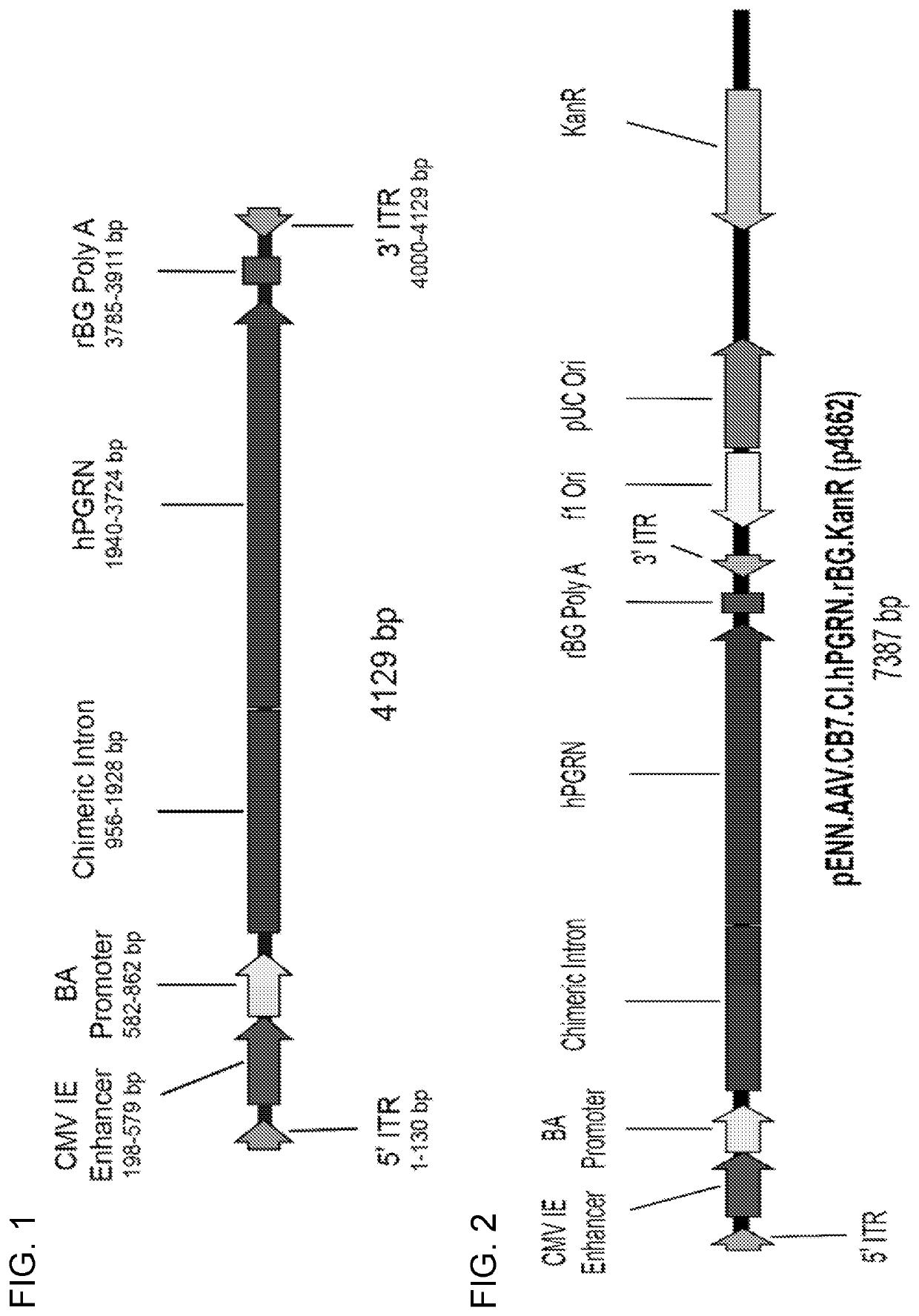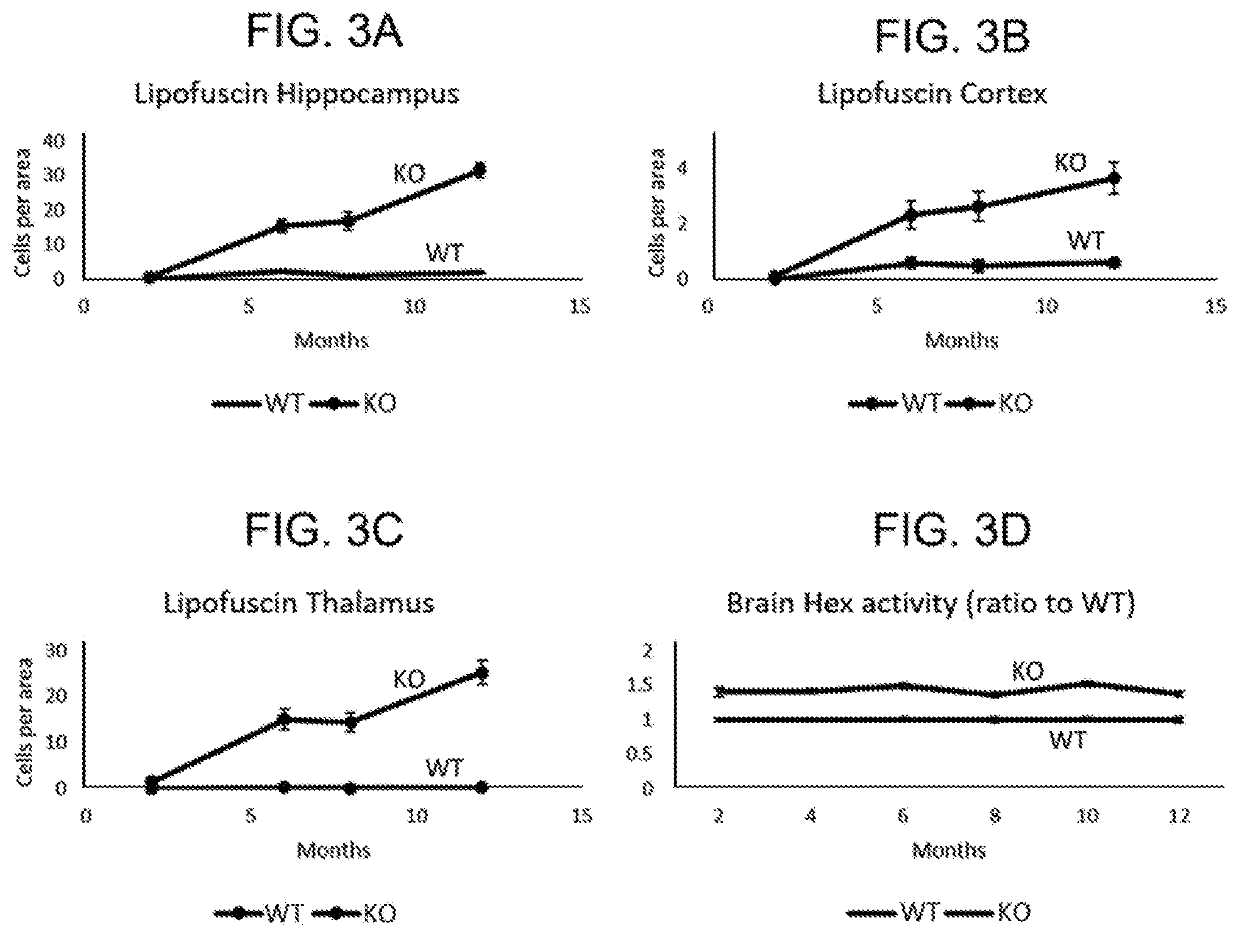Recombinant adeno-associated virus for treatment of grn-associated adult-onset neurodegeneration
a technology of adenovirus and adenovirus, which is applied in the direction of drug composition, peptide/protein ingredient, peptide source, etc., can solve the problem of no disease-modifying therapy for adult patients
- Summary
- Abstract
- Description
- Claims
- Application Information
AI Technical Summary
Benefits of technology
Problems solved by technology
Method used
Image
Examples
example 1
and Methods
Vectors
[0131]An engineered human PGRN cDNA was cloned into an expression construct containing a chicken beta actin promotor with cytomegalovirus early enhancer, a chimeric intron, and a rabbit beta-globin polyadenylation sequence (FIG. 1). A second engineered human PGRN cDNA was cloned into an expression construct containing the human ubiquitin C promoter. The expression constructs were flanked by AAV2 inverted terminal repeats. Adeno-associated virus serotypes 1, 5 and human 68 (AAVhu68) were generated from this construct by triple transfection of HEK293 cells and iodixanol purification as previously described (Lock M, et al. Hum Gene Ther. 2010; 21(10): 1259-71).
Animal Procedures
[0132]All animal protocols were approved by the Institutional Animal Care and Use Committee of the University of Pennsylvania. Breeding pairs of GRN knockout mice were purchased from The Jackson laboratory (stock #013175), and a colony was maintained at the University of Pennsylvania. Wild type ...
example 2
ted Delivery of a Human GRN Transgene in a Murine Disease Model
[0139]Recombinant AAV vectors having AAVhu68 capsids expressing human PGRN (SEQ ID NO: 3) under the control of a CB7 promoter and chimeric intron (CB7.CI.hPGRN.rBG) were produced using published triple transfection technques as described, e.g., WO 2018 / 160582.
[0140]We evaluated AAV-mediated delivery of a human GRN transgene in a GRN knockout mouse model. Mice heterozygous for GRN mutations (GRN+ / −) do not exhibit pathological hallmarks of GRN-related neurodegenerative disease, likely because the mouse lifespan does not allow for development of the sequelae of GRN haploinsufficiency, which first manifest after several decades in humans. In contrast, complete PGRN deficiency in GRN′ mice recapitulates several early hallmarks of GRN haploinsufficieny in humans, such as impaired lysosomal function, accumulation of autofluorescent lysosomal storage material (lipofuscin), and activation of microglia, though GRN− / − mice do not ...
example 3
ted GRN Gene Transfer in Nonhuman Primates
[0146]The findings in GRN− / − mice demonstrate that delivery of an AAV vector into the CSF can achieve sufficient brain transduction to produce therapeutic levels of PGRN and prevent or reverse biochemical and histological findings associated with PGRN deficiency. In order to translate this approach to humans, studies were carried out in nonhuman primates using ICM delivery, a clinically relevant route of vector administration. Intrathecal AAV delivery via injection into the cisterna magna is a minimally invasive approach that results in more extensive brain transduction than administration by lumbar puncture (Hinderer C, et al. Molecular therapy Methods & clinical development. 2014; 1:14051). NHPs aged 3-10 years old were utilized because this age is representative of the intended adult patient population. Rhesus macaques (N=2 per group) were administered a single image-guided ICM injection of an AAV1, AAV5, or AAVhu68 vector expressing huma...
PUM
| Property | Measurement | Unit |
|---|---|---|
| Fraction | aaaaa | aaaaa |
| Fraction | aaaaa | aaaaa |
| Electric charge | aaaaa | aaaaa |
Abstract
Description
Claims
Application Information
 Login to View More
Login to View More - R&D
- Intellectual Property
- Life Sciences
- Materials
- Tech Scout
- Unparalleled Data Quality
- Higher Quality Content
- 60% Fewer Hallucinations
Browse by: Latest US Patents, China's latest patents, Technical Efficacy Thesaurus, Application Domain, Technology Topic, Popular Technical Reports.
© 2025 PatSnap. All rights reserved.Legal|Privacy policy|Modern Slavery Act Transparency Statement|Sitemap|About US| Contact US: help@patsnap.com



